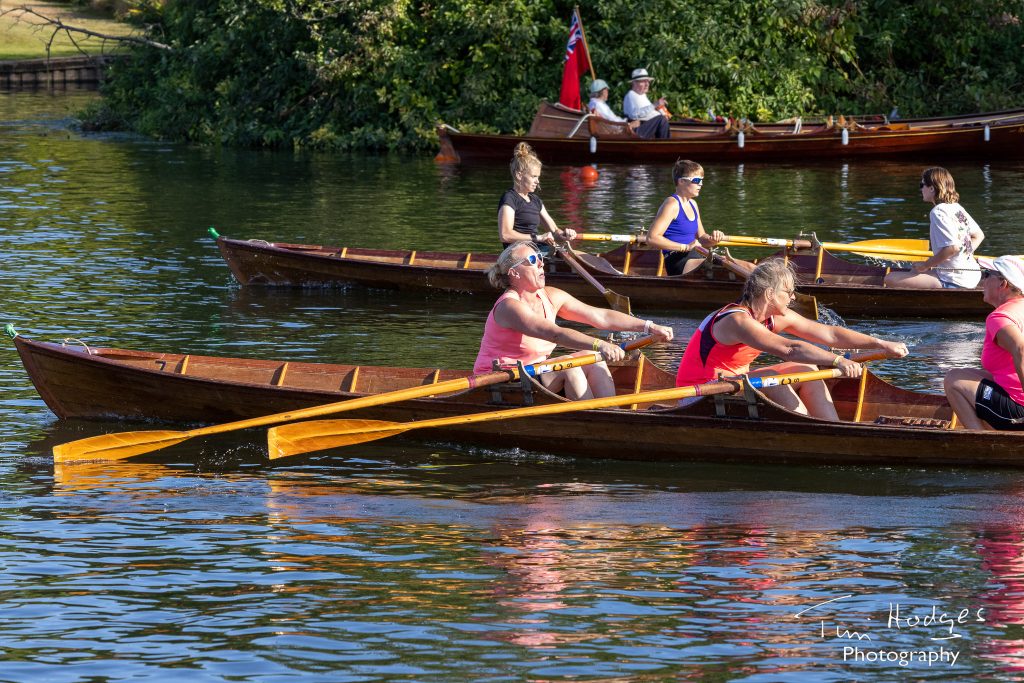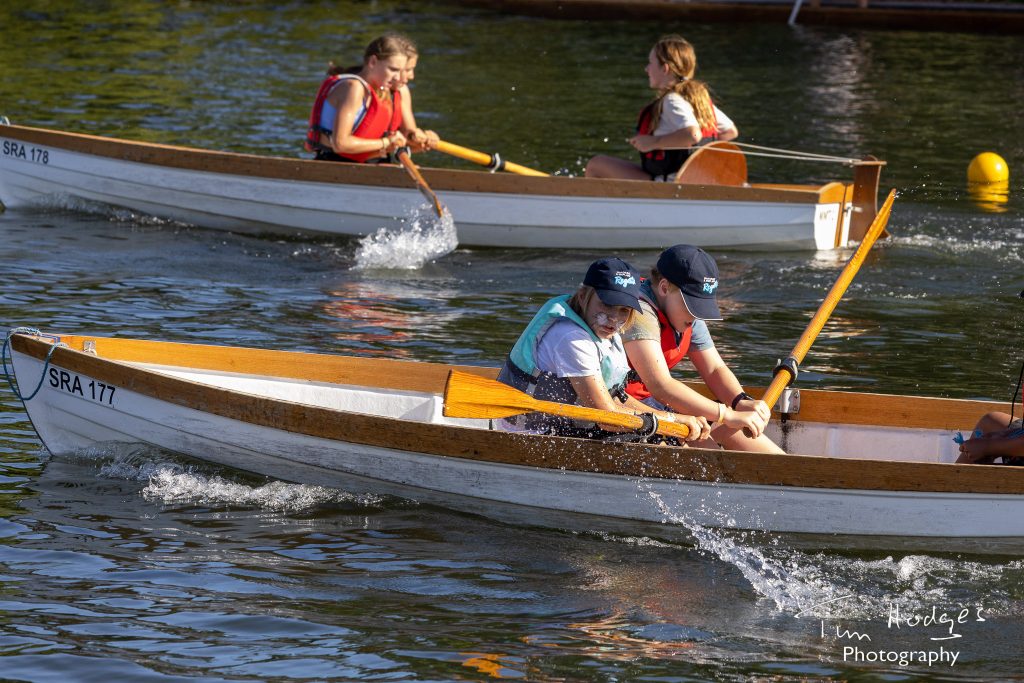There are over 300 races at the regatta starting early on the Friday morning and taking place in heats to get through to the finals on the Saturday.
The winners of the finals receive not only the glory of winning, but a medal and trophy too. Both beginners and experts can get great enjoyment from taking part.
The types of racing are (click on each one to jump to it):
Dongoling (great for first-timers and having a go)
Scratch Dongola
Punting
Punting in Canoes
Skiffing
Rowing (great for young children)
Canoeing
Regatta Swim
And for each of these disciplines there are various different races across all ages. Competitors can enter a maximum of six boating events (the Swim is run separately).
Read on to find out more about each one, and if you’d like to have a go at anything, we run two, free, afternoons at Wargrave Boat Club where you can learn the fundamentals of each event.
Dongoling
Dongoling is a little bit like dragon boat racing. Six people race in a punt against two other teams (minimum two women/girls), using paddles to move the boat through the water. The person at the back steers the punt.
Dongoling is the most popular event at the regatta and the easiest way to ‘have a go’.
Which races can I dongle in?
Adults
Grand Dongola:
Enter this if you’re taking part in other races. You can enter if you’re not taking part in other races but if your whole crew is just entering a dongola, the Thames is the one for you.
Thames Dongola:
Enter this if you’re not entering any other races. It’s a bit less serious than the Grand Dongola.
Veteran Dongola:
Combined age of the crew needs to be at least 300 years and each member must be at least 45 years old.
Note: you can only enter one adult dongola event. You can also enter the Jubilee Dongola. If you’re knocked out on Friday you CAN enter the Scratch Dongola on the Saturday (see below for details).
Children
Junior Dongola:
You must be under 17 years old.
Under 12 Dongola:
The crew is steered by an adult who must be over 18. The other five crew members have to be under 12 years old on the Saturday of the regatta.
Mixed ages
Jubilee Dongola:
Mixed age crew with at least two children under 11 years old. The steerer must be over 18. There’s also a prize for best fancy dress.
Scratch Dongola:
This is THE race for you if you want to enter the Regatta but don’t want to put a crew together. Absolutely no experience is needed. Register at the Regatta enclosure, just behind the Control Tent at the ‘finish’ end of the enclosure, from 9am on the Saturday morning (the queue usually forms before this!) and you’ll be put into a scratch team with five other people. Crews are drawn at midday and racing starts shortly after this. There’s a maximum of 36 crews in total and the spots are filled on a first come, first served, basis.
It costs £6 to enter and the crews are drawn randomly, with six people in each. Paddles are included in the entry, or you can bring your own. In each crew one person steers and you can volunteer for this position if you fancy it.
Training Tips: find out all about steering a dongola here and a beginners ‘how to’ here
Punting in a Punt
A punt is a flat-bottomed boat and the punter(s) uses a long pole to push the boat along.
The racing takes place in 2ft punts under Thames Punting Club (TPC) rules and it’s highly recommended to have a few lessons before taking part as there’s a skill to keeping the boat in a straight line and manoeuvring at each end of the course.
There is also punting in canoes – see below for more information on this.
Which races can I punt in?
If this is your first time competing in a punt, enter the Novice event(s). As soon as you’ve won a Novice event, move onto the Handicap races.
The handicap gives less experienced competitors an equal chance of winning, as they are given a head start. You only get to know your handicap when the programmes are issued, where your handicap is noted alongside your name.
xxx
Solo Women
Lady’s Single Punting Handicap:
Raced over two lengths of the course. A handicap of a certain number of seconds is given to each competitor, and the better you are the smaller the handicap. The competitor with the larger handicap sets off first and the umpire counts down the seconds before setting the second person off. (eg if George has a handicap of 25 seconds and Sam’s is 5 seconds, George will start first and Sam will start 20 seconds later (25 minus 5)).
Novice Status Lady’s Single Punting:
Open to women who have not previously won a Novice, or higher banded, punting event run under TPC rules, at any regatta on the Thames. You can, however, enter if you’ve won a Handicap race.
xxx
Solo Men
Gentlemen’s Single Punting Handicap:
Raced over four lengths of the course. A handicap of a certain number of seconds is given to each competitor, and the better you are the smaller the handicap. The competitor with the larger handicap sets off first and the umpire counts down the seconds before setting the second person off. (eg if George has a handicap of 25 seconds and Sam’s is 5 seconds, George will start first and Sam will start 20 seconds later (25 minus 5)).
Novice Status Gentlemen’s Single Punting:
Open to men who have not previously won a Novice, or higher banded, punting event run under TPC rules, at any regatta on the Thames. You can, however, enter if you’ve won a Handicap race.
xxx
Pairs
Lady’s and Gentlemen’s Double Punting Handicap:
Each crew is made up of one man and one woman and is raced over 4 lengths of the course. A handicap of a certain number of seconds is given to each crew, and the better you are the smaller the handicap. The crew with the larger handicap sets off first and the umpire counts down the seconds before setting the second crew off. (eg if George and Sam have a handicap of 25 seconds and Ash and Phil’s is 5 seconds, George and Sam will start first and Ash and Phil will start 20 seconds later (25 minus 5)).
Punting in canoes: see below
Training Tips: coming soon
Punting in Canoes

Instead of punting in a punt, this event takes place in a Canadian canoe, using a punt pole to push the boat along.
To do it well takes skill, and the finals are hotly contested, but this is a very popular event for first-timers and many end up in the water! Fancy dress is very much allowed but not a requirement.
Which races can I punt in a canoe in?
Solo Men
Single Punting in Canoe
Pairs
Lady’s Double Punting in Canoes
Double Punting in Canoes (single sex or mixed)
Training Tips: find out about technique and getting started here
Skiffing

Skiffing is done in pairs, in a long boat called a skiff. You use oars, called blades, and a rowing motion to move the boat. A cox sits at the back (the stern) and steers the boat with bits of rope that are attached to a rudder.
It’s advisable to have a lesson or two before competing in this event so you can get to grips with the blades.
Which events can I skiff in?
Adult events
Gentlemen’s Double Sculling Skiff:
No lower age limit but if you’re under 17 the Junior events will give you a better chance
Ladies’ Double Sculling Skiff:
No lower age limit but if you’re under 17 the Junior events will give you a better chance.
Lady and Gentleman’s Double Sculling Skiff:
No lower age limit but if you’re under 17 the Junior events will give you a better chance.
Veteran Gentlemen’s Double Sculling Skiff:
Each sculler must be over 40 years old. Aggregate of both scullers at least 100 years.
Veteran Lady & Gentleman’s Double Sculling Skiff:
Each sculler must be over 40 years old. Aggregate of both scullers at least 90 years.
Junior and Children’s Events
Boy & Girl Double Sculling Skiff:
You must be under 16, including the cox
Boy’s Double Sculling Skiff:
You must be under 17, including the cox
Girl’s Double Sculling Skiff:
You must be under 17, including the cox
Training Tips: coming soon
Rowing
Rowing takes place in a dinghy, with a pair of short oars. It’s a really popular event for children and a great way to take part in the regatta for the first time.
Which events can I row in?
Children’s events
Side-by-side Dinghy:
Two people rowing side-by-side. Must be under 12. The cox (person steering at the back) can be any age, so for very young children an adult can be in the boat with them.
Under 12 Dinghy:
One person rowing. No cox. Must be under 12
Under 15 Dinghy:
One person rowing. No cox. Must be under 15
Adult Events
Lady’s Dinghy: one person rowing. No cox.
Training Tips: coming soon
Canoeing
Canadian canoeing involves one or two people in each canoe, kneeling and paddling to propel the boat forward. Steering a canoe and keeping your balance need a bit of practise.
Which events can I canoe in?
Gentleman’s Canadian Canoe: no lower age limit.
Lady & Gentleman’s Canadian Canoe: no lower age limit but if you’re under 17 year’s old the Boy & Girl race will give you a better chance.
Boy & Girl Canadian Canoe: you need to be under 17 year’s old.
Training Tips: coming soon
Regatta Swim

The popular Regatta Swim takes place early on the Saturday morning of the regatta. There’s a 1km and 2km race, along with a Go With the Flow category down the regatta course. Entry for the Swim is via a separate booking platform to the main regatta.
The 1km and Go with the Flow categories are open for anyone aged 12 years and up.
Find out all the details here:
Distances
General Information and FAQs
If you’d like to have a go at anything, we run two, free, afternoons at Wargrave Boat Club where you can learn the fundamentals of each event








